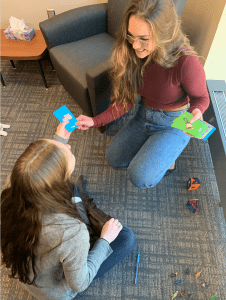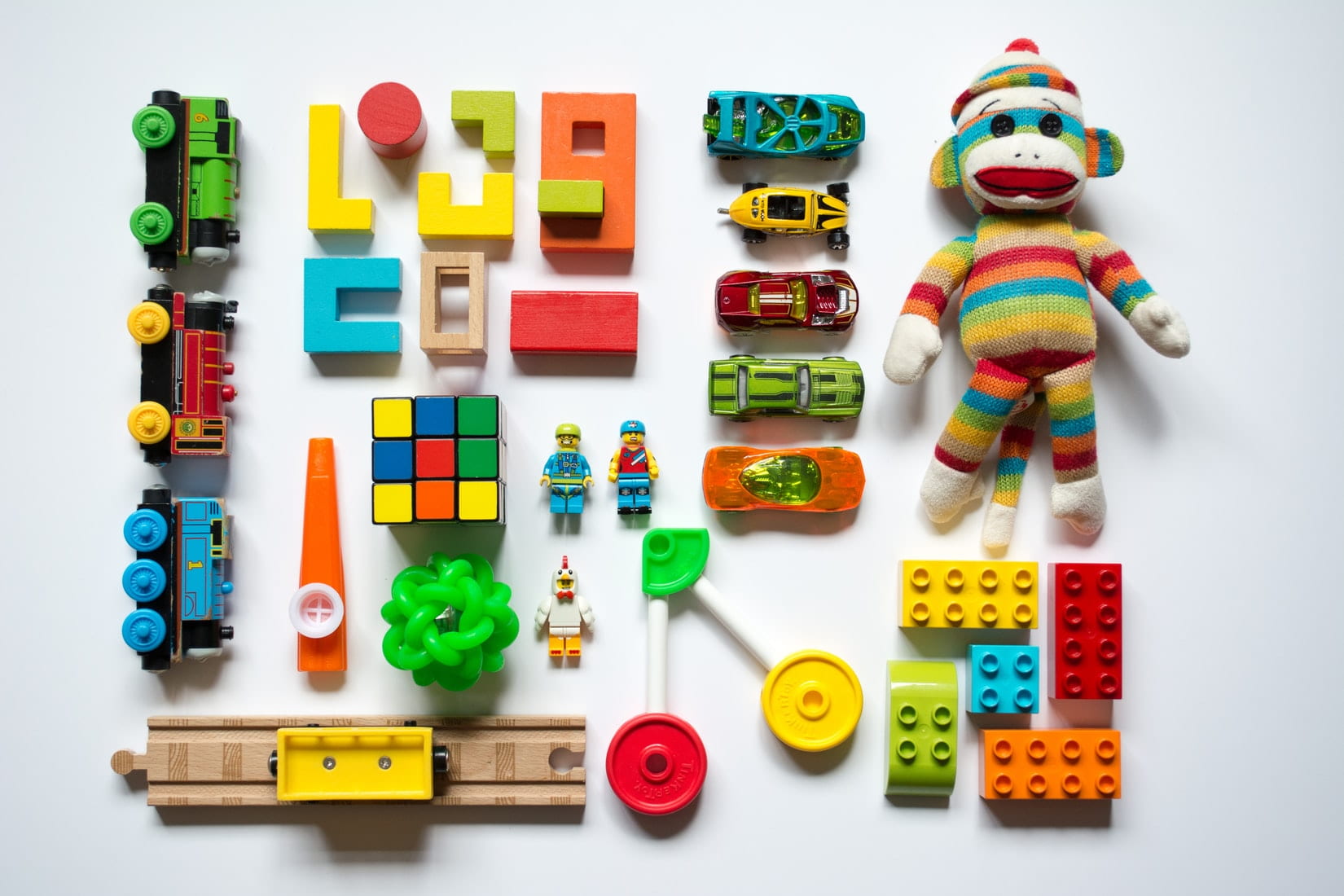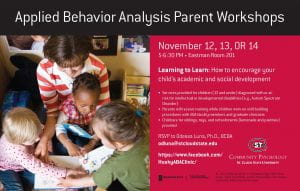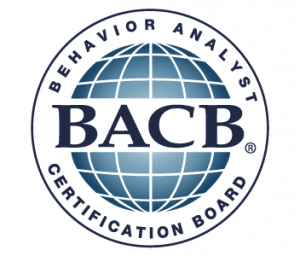November 2019 archive
 Over the last dew days you have learned about creating opportunities to teach, waiting for the correct response, and giving prompts if you child isn’t picking up on the sublet hints. In our final blog series of embedded teaching, we aim to teach you on how to use positive consequences or natural actions to encourage appropriate behavior. Often, we call this positive reinforcement. We don’t always have to use extrinsic or outside rewards like candy, screen time, or tokens. Instead, we can more natural reinforcers to encourage your children to appropriately communicate.
Over the last dew days you have learned about creating opportunities to teach, waiting for the correct response, and giving prompts if you child isn’t picking up on the sublet hints. In our final blog series of embedded teaching, we aim to teach you on how to use positive consequences or natural actions to encourage appropriate behavior. Often, we call this positive reinforcement. We don’t always have to use extrinsic or outside rewards like candy, screen time, or tokens. Instead, we can more natural reinforcers to encourage your children to appropriately communicate.
For example, maybe, you are trying to teach your child to use “please” when they ask for items they want. First, you create and wait, by pointing to a toy that is out of your child’s reach. You count in your head for at least 3 seconds, and then you remind or prompt your child what they need to do. This can be accomplished by saying “Remember to say please when you ask your mom or dad for toys.” Once your child states, “Can I have the toy, please?” Immediately acknowledge this communication and reinforce this by giving the child the toy quickly. Always try to associate this this natural, positive consequence with your affirmation, encouragement, and acknowledgement. Natural reinforcers may include verbal praise, such as, “Wow! I’m so proud you are using manners!” Always try to very specific when giving acknowledgement to your child. This allows your child to learn what they did correctly and be motivated to repeat the behavior again.
Some children may struggle communicating vocally, and that’s okay. We can still use embedded teaching for them to learn appropriate ways to meet their needs. If your child is nonverbal (that is, does not talk to communicate his/her needs), we may want to teach them to point to items they may need. If a toy is out of reach, you would still create and wait and prompt(remind) the child to point to what they need. Once your child points or you help them point to what they want, you can reinforce their nonverbal communication with giving them the toy. Remember to always tell your child what they did correctly “Nice pointing to what you needed!” to encourage them to continue to point to items.
Embedded teaching (or sometimes called naturalistic or incidental teaching) is an excellent technique that our faculty and graduate clinicians use all the time at the Husky ABA clinic. We capitalize on learning opportunities in real-world contexts to teach your child to communicate appropriately. Embedded teaching is a fantastic way to teach new behaviors in your everyday life!
Check out our Facebook page for a demonstration of these techniques!
Like us on FaceBook!
 In our last post, we outlined about the “create and wait” technique of embedded teaching. This is when you create a situation that would require a specific response from your child and wait for them to engage in the correct behavior. What happens if your child does not respond (stares at you blankly) or responds incorrectly? It may be necessary to remind, model, or prompt your child what they need to do! For example, you may give hints to your child about what you are expecting them to do.
In our last post, we outlined about the “create and wait” technique of embedded teaching. This is when you create a situation that would require a specific response from your child and wait for them to engage in the correct behavior. What happens if your child does not respond (stares at you blankly) or responds incorrectly? It may be necessary to remind, model, or prompt your child what they need to do! For example, you may give hints to your child about what you are expecting them to do.
For example, when you are the grocery store, you allow your child to pick a snack they like for the week. Perhaps, the goldfish are on the top shelf and they cannot reach it. Rather then grabbing the item, create and wait.Count to three in your head to see if they will ask for your help. If they don’t ask, try to prompt or give hints to what your child needs to do to get the gold fish. First, you point at the goldfish. Second, you may say, “What do we say when we need help from mom or dad?” Finally, you may prompt or remind your child to say, “Say ‘I need help, please.”
By prompting or reminding,this gives your child to understand and figure out what you want them to do. Often, you may notice your child needs lots of prompts.Over time, you will start to notice the number of hints, reminders, or prompts will decrease. You will notice your child is communicating more and relying less on your prompts. Remember with embedded teaching, the goal is to encourage more communication. At the Husky ABA clinic, graduate and faculty clinicians want to promote language by embedding earning opportunities at any given moment.
Check out our Facebook page for a demonstration of these techniques!
Like us on FaceBook!
 Teaching your child new skills can be difficult. One way to teach your child new skills, without them even realizing it, is through embedded teaching (sometimes called naturalistic teaching or incidental teaching). The first step in embedded teaching is “create and wait.” This is when you create opportunities for your child to practice a skill (like asking for something they need) and wait for your child to do what is needed.
Teaching your child new skills can be difficult. One way to teach your child new skills, without them even realizing it, is through embedded teaching (sometimes called naturalistic teaching or incidental teaching). The first step in embedded teaching is “create and wait.” This is when you create opportunities for your child to practice a skill (like asking for something they need) and wait for your child to do what is needed.
Embedded teaching can be done anywhere! Often embedded teaching is a fantastic way for your child to learn to request for their wants and needs. For example, your child may be at the table during breakfast with a dry bowl of cereal. This would be a terrific opportunity to for your child to request for some milk! Instead of just pouring the milk, wait for your child to ask for it! When you notice your child may need something (like milk or spoon), create and wait by counting in your head to three. This allows your child time to notice what they need. Those three seconds allows them some time to identify what is missing.
Clinicians at the Husky ABA clinic use embedded teaching every time we work with your child, and we hope to teach you, as a parent, to create these small, meaningful opportunities for your child to practice communicating, requesting, and using manners in your home, at the park, or at the store!
Check out our Facebook page for a demonstration of these techniques!
Like us on FaceBook!
 Meet Samantha!
Meet Samantha!
Samantha is in her second year here at St. Cloud State. She comes from Minnesota State University Moorhead, but ended up finishing her bachelor’s degree at SCSU. She received a degree in Community Psychology with a minor in Communication studies in 2018 and was accepted into the ABA program right after. Her parents are also alumni of SCSU, and she has been coming to campus since she was young and started off her experience at the college in the Lindgren child center. While she didn’t originally decide to come to SCSU she is happy she’s here and loves learning from the professors who are all very knowledgeable in their subjects.
Samantha previously worked with high functioning preschool-aged children in a day treatment environment that was designed to emulate a classroom. She currently works in a level four special education classroom in a general education middle school. The students are lower functioning and engage in high rates of physical aggression, verbal aggression, elopement, and property destruction. While she enjoys working with children of all ages, she thinks found her niche in middle school.
Something interesting about Sam is that she had a heart attack during her first year of college and acquired two neurological disorders. The primary symptoms include sudden loss of consciousness, vertigo, migraines, and chronic fatigue. To aide in her disability, she received a medical alert and mobility assist dog from the local organization, Can Do Canines (they are located in New Hope, MN). Her dog Obie helped her regain her independence and ensured that she could safely attend classes on campus again. After five years as a team, Obie is now retired and spends his days sleeping in the sun next to Luna, his kitty best friend. Obie and Samantha are now featured on a vehicle that was donated to Can Do Canines by Subaru.
 Although behavior analysts can help anyone with behavioral challenges, we often work with children and adults diagnosed with autism spectrum disorder (ASD). Interventions based on ABA can be very beneficial to people diagnosed with autism. Not only is it backed by decades of research, it has become widespread in popular culture.
Although behavior analysts can help anyone with behavioral challenges, we often work with children and adults diagnosed with autism spectrum disorder (ASD). Interventions based on ABA can be very beneficial to people diagnosed with autism. Not only is it backed by decades of research, it has become widespread in popular culture.
Children and adults diagnosed with ASD are very intelligent. Often, they may have a hard time communicating their feelings to others and why they may behave in a way that is confusing. Since BCBAs based their interventions on what actions a client does, a child or adult who cannot communicate is not something BCBAs worry about. Instead, we outline actions we want to see the client do more, and we measure how well our interventions work on increasing the appropriate behavior.
Interventions in ABA are effective for those diagnosed with ASD because we know each person is a unique individual. No two children are the same. Clinicians in ABA prioritize getting to know the child and make their treatments fit their needs. We recognize that those diagnosed with ASD may engage in actions that are confusing to teachers, parents, community members, and siblings. This can lead to frustration, and we, clinicians from the Husky ABA clinic, want to help!
At the Husky ABA clinic, we are experts in producing meaningful behavior change. This may create an individualized plan to teaching a child to independently toilet. Or teaching a child to recognize their frustration and ask for help! In addition, we work with families, teachers, and other important people in the child’s life to create positive environments.
Like us on Facebook!
 Meet Kelsey!
Meet Kelsey!
She is another second-year student at St. Cloud State in the ABA program. Kelsey received her undergraduate Psychology degree at the University of Wisconsin- River Falls. She has also worked at a center for children diagnosed with Autism Spectrum Disorder (ASD) for three years. While working at this clinic she started to show an interest in the field of ABA. She is currently doing in-home therapy for children diagnosed with ASD while working towards her master’s degree.
Kelsey chose to come to St. Cloud State because her coworkers encouraged her to check out the master’s program. She says that she thought the program would be easier than it is, but she could not be happier at SCSU and is also learning so much more than she ever imagined. All the professors want students from the ABA program to come out of it with as much knowledge and experience as possible, and because of this, all the classwork can be challenging at times, which is why Kelsey says one of her biggest accomplishments so far has been making it through the first year of the program.
A not-so-fun fact about Kelsey is that her laptop crashed during finals her first semester in the program, so now she prints all her work or has it on one of many flash drives, so she never loses it again. She also prints out every article from class (which can be up to 10 a week) and loves to use highlighters to pick out the most important information.
Like us on FaceBook!

Photo by: Vanessa Bucceri
When a board certified behavior analyst (BCBA) first meets their client, they prioritize in building a positive relationship with the child. They want to know what their client likes and is motivated for. BCBAs are all about reinforcing good behavior. BCBAs often receive information from caregivers and people who have worked with children in the past on what they like. We know that preferences change frequently, so a BCBA will take time to systematically assess the child’s preferences after receiving recommendations from a parent.
The most common way a BCBA finds out what a child likes is through a preference assessment. Most preference assessments contain 5-10 items that may include toys, snacks, or activities. The first set of choices that are used are often picked based on information from caregivers and what is available to the BCBA at the time. Some common things that children work for are crackers, breaks (just having time to lay down or sit), electronic devices, toys, and time in the gym or on the playground.
The preference assessment included at the top of this post is called a Multiple Stimulus Without Replacement (MSWO). In this assessment the child is presented with multiple items (7 were used in the example) and they are asked to pick on item at a time, after they pick an item they get to spend time playing with it or eating it, and then that choice is no long available to them. This process repeats until the child has picked each of the items once, and the order in which they chose is recorded. Then the order in which the items are lined up is changed and the process starts over. At the end of the assessment items that a child chose first most often are identified at the high preference items.
Check out our Facebook page for a video demonstration!
Join us at our upcoming clinic sessions by RSVPing to Dr. Odessa Luna. Our upcoming Clinic topic is: Learning to Learn: How to encourage your child’s academic and social development. Dates will be November 12, 13, and 14 at 5:00 pm
.
Any other clinic sessions and updates will be posted on the clinic facebook, give it a like: https://www.facebook.com/HuskyABAClinic

Photo retrieved from BCBA.com
Within the field of applied behavior analysis (ABA), there are many titles a clinician can have. BCBA stands for Board Certified Behavior Analyst. Clinicians who hold this title have received a master’s degree, completed at least 1,500 hours of supervised work with implementation of behavior-analytic work, and taken an international certification exam. At the Husky ABA clinic, we have four faculty advisors who are BCBA-Ds, meaning that they have a doctorate degree in ABA or related behavior.
You may have noticed another title, the BCaBA, Board Certified assistant Behavior Analyst. BCaBA have undergraduate degree, completed at least 1, 000 hours of supervised works, and have passed an international certification exam. BCaBA’s
practice under the supervision of a BCBA, monitoring front-line clinicians that are implementing the individualized interventions the BCBA has created.
Finally, front-line clinicians in ABA, are often Registered Behavior Technicians (RBT). RBTs hands-on with the clients, directly implementing structured programming to help the child to be successful. RBTs work with clients every day to implement the interventions written by the BCBAs. RBTs are heavily supervised by both the BCaBA and BCBA to ensure treatments are implemented with fidelity.
Overall, in ABA, we aim to identify the changes we need to make in the environment to enhance the lives of clients AND the individuals around them like their parents, teachers, classmates, and siblings.
For more information about Applied Behavior Analysis check out https://www.bacb.com
Like us on FaceBook!
 Over the last dew days you have learned about creating opportunities to teach, waiting for the correct response, and giving prompts if you child isn’t picking up on the sublet hints. In our final blog series of embedded teaching, we aim to teach you on how to use positive consequences or natural actions to encourage appropriate behavior. Often, we call this positive reinforcement. We don’t always have to use extrinsic or outside rewards like candy, screen time, or tokens. Instead, we can more natural reinforcers to encourage your children to appropriately communicate.
Over the last dew days you have learned about creating opportunities to teach, waiting for the correct response, and giving prompts if you child isn’t picking up on the sublet hints. In our final blog series of embedded teaching, we aim to teach you on how to use positive consequences or natural actions to encourage appropriate behavior. Often, we call this positive reinforcement. We don’t always have to use extrinsic or outside rewards like candy, screen time, or tokens. Instead, we can more natural reinforcers to encourage your children to appropriately communicate.







